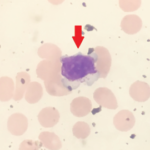“Pubertal delay is an important factor in peak bone mass. The later the onset of puberty, the lower your peak bone mass,” said Dr. Burnham. Glucocorticoid therapy may also reduce their sex steroids, muscle mass and calcium absorption, all contributing to lower bone mass. In these chronically ill patients, osteoclast development increases under the influence of RANK ligand, increasing bone resorption. They may have less osteoblast formation and lower bone formation, he said. “All of these factors converge to create lower bone mass and increased risk of fracture during childhood.” After skeletal maturation, when bone mass begins to decline, adult patients with a history of rheumatic disease during childhood may “reach the fracture threshold earlier than a person with relative health would,” Dr. Burnham said.
Dual-energy X-ray absorptiometry (DEXA) imaging helps rheumatologists assess bone mineral content and areal bone mineral density (BMD). Consider DEXA testing after a patient has taken six to 12 months of glucocorticoids, Dr. Burnham said.
Scores are strongly correlated with the patient’s height, Dr. Burnham said. “Patients with short stature will have a lower area BMD, even if their bones have normal volumetric density.” DEXA Z-scores may be adjusted at least for sex and age, and ideally, for race or other factors that may affect bone density. Z-score calculations that mitigate height bias can now be calculated on the Bone Mineral Density in Childhood Study website (http://www.bmdcspublic.com), he said.
A diagnosis of osteoporosis in a pediatric patient should not be made on the basis of densitometric criteria alone, Dr. Burnham said. A patient should have experienced one or more vertebral compression fractures in the absence of local disease or trauma. Alternatively, a patient should have two or more long bone fractures by age 10, three or more long bone fractures at any age up to 19, or a BMC or a BMD Z-score of less than or equal to -2.
JIA patients face unique risks, he said. “Kids with JIA will all have the same bone risk factors as healthy kids,” including age, gender, nutritional status, intrauterine environment, genetic load, geography and risk-taking behaviors. “But JIA results in impaired cortical and trabecular bone accrual,” possibly due to medications, disease activity and lower muscle mass. They may be at greater risk for falls because of altered balance or muscle weakness, and face higher fracture risks in their arms and legs. If they have one fracture, they have an increased risk of another fracture later on, said Dr. Burnham.

